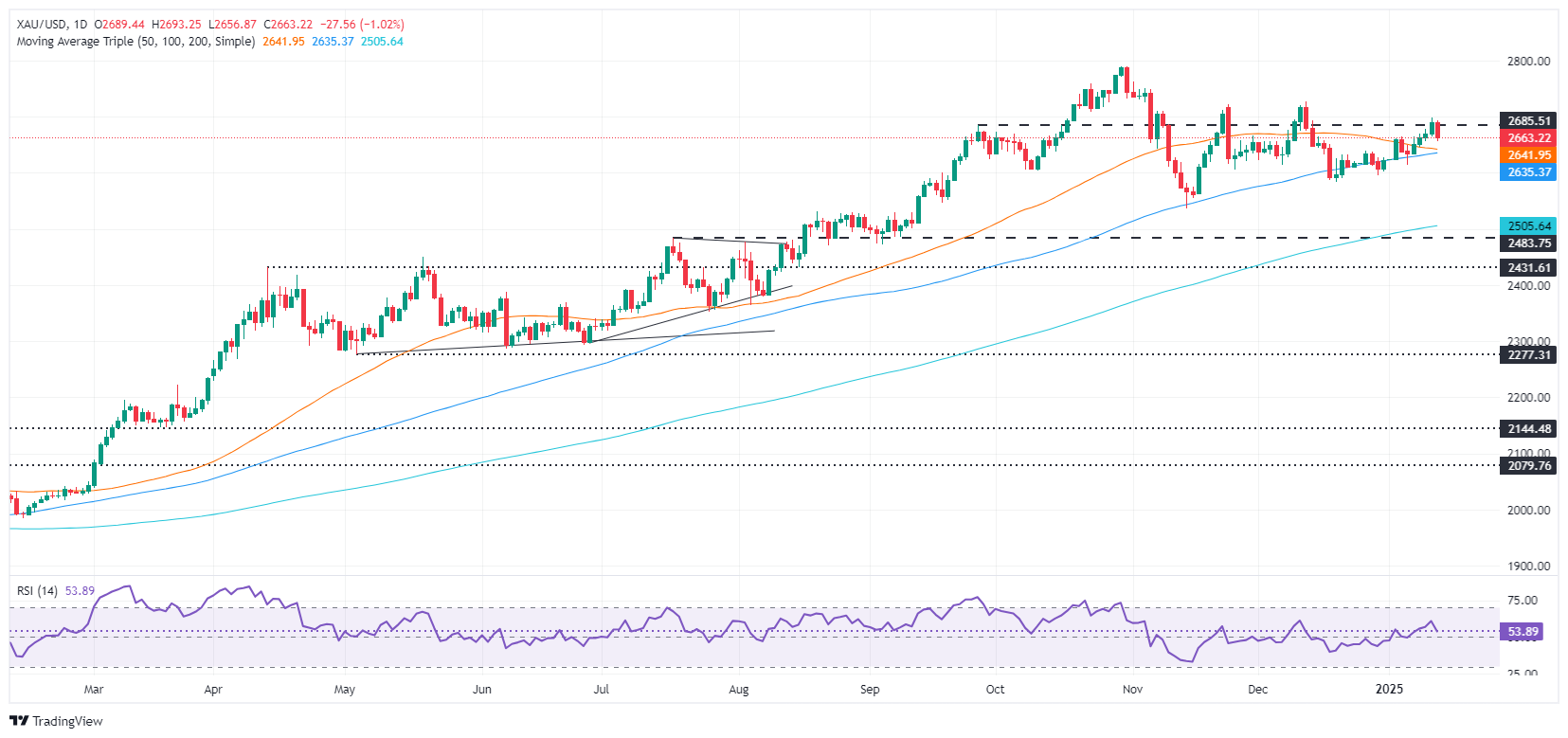- Gold slides as DXY cleared 110.00 for the first time since November 2023.
- Traders trimmed Fed rate cut odds, after US jobs data, CPI eyed.
- XAU/USD sellers eye $2,650 and 100-day SMA near $2,630.
Gold price retreats during the North American session as traders seeking safety bought the Greenback as United States (US) Treasury bond yields rose to their highest level since November 2023. At the time of writing, the XAU/USD trades at $2,657 after failing to clear $2,700, down 1.20%.
A scarce economic docket on Monday keeps investors digesting the latest US Nonfarm Payrolls figures for December. Although the economy has fared better than expected, with figures rising by 256K exceeding forecasts of 160K and November’s 212K, traders are eyeing the release of US inflation data.
On Wednesday, the Consumer Price Index (CPI) for December will be announced, with estimates at around 2.8% YoY, up from November 2.7%. The Core CPI, which excludes volatile items, is projected to remain unchanged at 3.3% YoY, unchanged from the latest three-months readings.
Inflation data could shifttraders expectations of Fed easing. Meanwhile, money market futures data has shown that most investors are expecting just 25 basis points of easing, leaving the fed funds interbank rate at 4.00%, down from the current 4.25% – 4.50% range.
Federal Reserve – Interest rate probability. Source: Prime-Market Terminal
Meanwhile, US Treasury bond yields cling to minimal gains, while the Greenback, after breaking the 110.00 mark, has retraced below the latter but it remains in the green.
Bullion prices are also taking a hit amid good news of a possible deal that could end Gaza’s war, via Reuters, citing an official briefed on the matter.
In seven days, US President-elect Donald Trump will be sworn as the 47th President. The financial markets are awaiting its first executive orders, with some speculation growing that he would impose the first tariffs. Recently he said that he has to do something regarding trade with Mexico and Canada.
In the US, key data releases include inflation figures on the producer and consumer sides, alongside Retail Sales and jobless claims for the week ending January 11.
Daily digest market movers: Gold price falls as US Dollar advances
- Gold price faces headwinds amid high US real yields, which rise three and a half basis points by two bps to 2.30%. At the same time, the US 10-year T-note yield soared seven and a half bps to 4.767%.
- The US Dollar rose sharply to multi-month highs according to the US Dollar Index (DXY). The DXY hit 110.17 before trimming gains and is at 109.85, up 0.20%.
- The US 10-year Treasury bond yields rises two basis points, up at 4.786%.
- Easing expectations of the Federal Reserve continued to edge lower. The December Fed funds futures contract is pricing in 30 basis points of easing.
XAU/USD technical outlook: Gold price clings above $2,650 despite retracing
Gold’s uptrend halted on Monday as a ‘bearish-engulfing’ pattern emerges in the daily chart, an indication that sellers are gathering some momentum. This is slightly confirmed by the Relative Strength Index (RSI), which despite remaining bullish, edges down towards its neutral level. Hence, in the short term further downside is seen.
If XAU/USD drops below $2,650, the next support would be the 50-day Simple Moving Average (SMA) at $2,643, followed by the 100-day SMA at $2,633.
On the other hand, if XAU/USD reclaims $2,700, the next resistance would be the December 12 high of $2,726 and the all-time high (ATH) at $2,790.
Economic Indicator
Nonfarm Payrolls
The Nonfarm Payrolls release presents the number of new jobs created in the US during the previous month in all non-agricultural businesses; it is released by the US Bureau of Labor Statistics (BLS). The monthly changes in payrolls can be extremely volatile. The number is also subject to strong reviews, which can also trigger volatility in the Forex board. Generally speaking, a high reading is seen as bullish for the US Dollar (USD), while a low reading is seen as bearish, although previous months’ reviews and the Unemployment Rate are as relevant as the headline figure. The market’s reaction, therefore, depends on how the market assesses all the data contained in the BLS report as a whole.
Read more.















